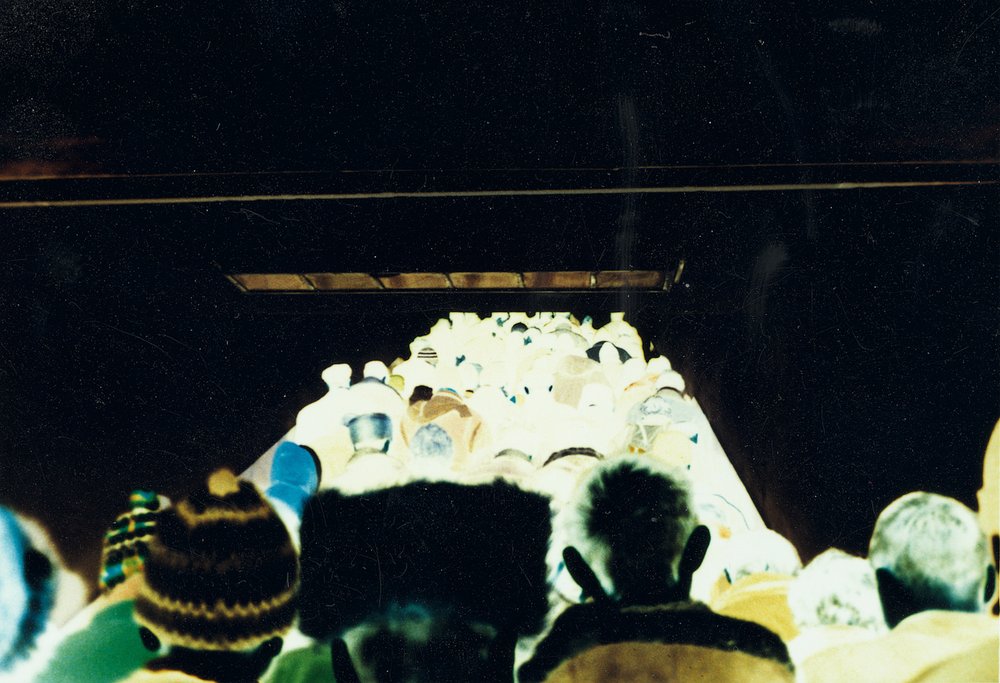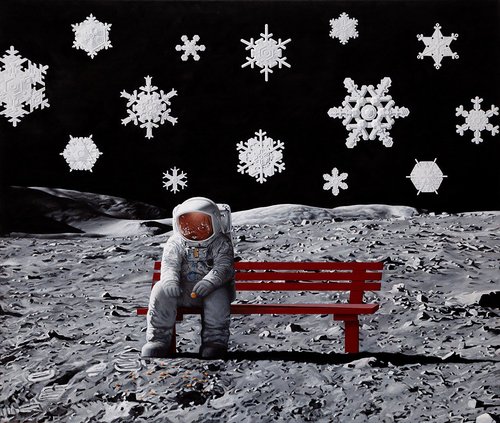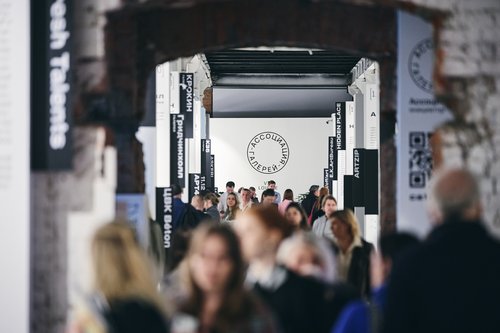Contour Art Fair Elevates to National Prominence

Olga Chernysheva. From the series 'Light is coming'. pop/off/art booth. Courtesy of Contour Art Fair
The third edition of Contour art fair which specializes in works on paper, has expanded to include a new section dedicated to the art of photography. Well curated and with an impressive roster of Russian domestic galleries, art critic and curator Sergey Khachaturov believes it is a great example of how artistic excellence can flourish beyond the traditional art capitals.
Contour is an art fair in Nizhny Novgorod dedicated exclusively to works on paper. This year, spread between two major venues in the city – the underground car park at the Seraton Hotel and in a vast trading hall in the Mytny Market – the fair’s real achievements were clear to all who visited it this year, and the impressive scale and quality put it on a par with more mainstream, established commercial art forums like Cosmoscow and Catalog.
Founder, Dmitry Volodin, talks persuasively of the need to expand the territory of art – and this year there was a new institutional focus at Contour on photography with twenty-one galleries housed in the Mytny Market hall featuring exceptional works by classic and contemporary Russian photographers. The pavilion’s luminous vaulted space with numerous windows gave visitors an unusual 3D experience of the photographic image, the photos were integrated into a large installation and appeared to literally float in space. Perhaps ‘Contour. Photo’ as it is called can even emerge as one of the most interesting photographic art festivals in Russia in terms of its exhibition design.
At ‘Contour.Photo’, PiranesiLAB – who like some other galleries had booths in both the photographic and main works on paper sections of the fair – was showing works by its founder, Alexey Veselovsky (b. 1969). These were large scale landscapes created using a vintage technique which reconstruct some of the earliest photographic experiments in pictorialism with prices ranging from 150,000 to 200,000 roubles (approximately 1,700 to 2,200 Euros). In one of the display cases on the gallery’s stand, I saw an album by the classic Moscow conceptualist Igor Makarevich (b. 1943), called ‘Changes’. In collaboration with the artist, Veselovsky recreated a series of Makarevich’s self-portraits with his eyes closed, from when he was a young man until 2018. It is a philosophical series, reminiscent of old master etchings about the ages of life and the melancholy of memory, created using heliogravure, which combines photographic light printing on plates with the use of an engraving press to produce impressions.
Large sized photographs by well-known artists like Evgeny Granilshchikov (b. 1985), Olga Chernysheva (b. 1962), Elena Samorodova (b. 1973) and Sergey Sonin (b. 1968) ranged in price from 200,000 to 500,000 roubles (approximately 2,200 to 5,500 euros) at prestigious galleries the likes of a-s-t-r-a, Jessica, pop/off/art and Anna Nova.
Among the younger participants at ‘Contour.Photo’ was Anna Tagantseva’s ‘Devyatnadtsat' Gallery' that had a standout booth where she was showing a new generation of artists. Ceramic vases by Anastasia Gorbunova, photographs by Milissa Page, Ekaterina Serikova, and others mysteriously brought together organic nature and fragments of our technogenic civilization. The dead world and the living world intertwined in fanciful arabesques and Anna Tagantseva’s words that in aggregator object-oriented art, the ideas of symbolism, Art Nouveau, and decadence are revived in unusual ways seemed to hold true. The price range for young art here was a lot lower – you could acquire a photograph by a new name for as little as 15,000 to 20,000 roubles (approximately 170 to 220 Euros), or something very special for 700 Euros.
The main section of the Contour fair dedicated to works on paper impressed visitors with its top quality presentation of both classics of unofficial Soviet art and contemporary artists. Nearly fifty galleries from across Russia installed their booths in the underground car park of the Sheraton. The most expensive work on sale at Contour by a Russian artist was an early pencil landscape by Dmitry Plavinsky (1937–2012) with a letter written on the reverse, offered by E.K.Artbureau for 2,200,000 roubles (approximately 24,500 Euros). At the Postrigay gallery, interesting, early abstract works by Anatoly Zverev (1931–1986) were priced at around 900,000 roubles (10,000 Euros) and ARTZIP gallery was selling works on paper by Vladimir Yankilevsky (1938–2018), Pavel Pepperstein (b. 1966), and labour camp drawings by Yulo Sooster (1924–1970) where prices ranged from 3,000 to 4,000 Euros. By the third day of the fair, many drawings had been sold.
KHLAM gallery from Voronezh offered works by the young conceptualist Mikhail Dobrovolsky (b. 1994) which sold well, all of his layered paintings with contour collages finding buyers, prices were set between 30,000 and 60,000 roubles (approximately 330 to 670 Euros). Local Nizhny Novgorod based gallery 9B also found success in selling virtuoso punk graphics of Evsti Bomse (b. 1996) which were flying off the stand for 15,000 to 20,000 roubles (approximately 170 to 220 Euros).
New Moscow gallery Masla Lisse made its debut at the fair. Its directors, artist Slava Nesterov (b. 1989) and art critic Sergey Guskov, brought works by young artists and curated the exhibition like a puzzle. From both sides of the booth works spread out pointing towards a large painting in the centre, ‘In Search of a Star’ by Slava Nesterov, a night landscape with mysterious glowing lights with quotes from all the works on their display from Mika Zon’s cyber-rabbits to pyrographic abandoned buildings by the street artist Nikita Etogde. According to Slava Nesterov, the idea behind it was inspired by the symbolist Maurice Maeterlinck’s play ‘The Blind’, in which blind people lose their guide in the wilderness but discover how to navigate into their subjective worlds through an inner vision. The real hit of their booth was the art of Pastor Train, the pseudonym of a technology teacher from Kaluga, an autodidact living in St. Petersburg where he works as a warehouse keeper – just like residents of Soviet squats in the good old days! His silk-screen prints and postcards created in the stereo-vario printing technique are assembled like fragments of fantastic dreams, close to the aesthetics of fantasy, fan fiction, and alchemical ciphers in the art of Nesterov himself. Prices for young art were affordable with Pastor Train’s stereo postcards and small silk-screen prints selling briskly for 7,000 to 8,000 roubles (approximately 90 to 90 Euros). Nikita Etogde’s abandoned buildings burned onto wood were valued at 20,000 roubles (approximately 220 Euros).
The interesting, layered design of the Jessica gallery booth was conceived by Masha Sha (b. 1982) and Nestor Engelke (b. 1983). In the centre, the gallery curators placed a model car woven from scraps of white canvases on a frame, playfully referencing the underground car park where the fair was held. And a car park is neither a road nor a home, rather a liminal, ghostly, threshold space.
A booth that was outstanding for its serious approach to cultural promotion, in this case of St Petersburg art, was gallery Luda and in particular their representation of artist Pyotr Beliy (b. 1971). Many artists of different generations were shown at the booth, with prices for works on paper by Vasya Khorst (b. 1987) and ‘Lyuda’s’ discovery, the neo-naive artist Alisa Gvozdeуva (b. 2006), ranged from 15,000 to 30,000 roubles (approximately 170 to 330 Euros). There were also albums with collections of lithographs by a variety of artists. They are normally presented at the end of the year to members of the gallery’s club of friends. Each month, a friend of the gallery pays a membership fee of 15,000 roubles (approximately 170 Euros). In this way, they both support the gallery and contribute to the creation of an archive of works on paper.

















